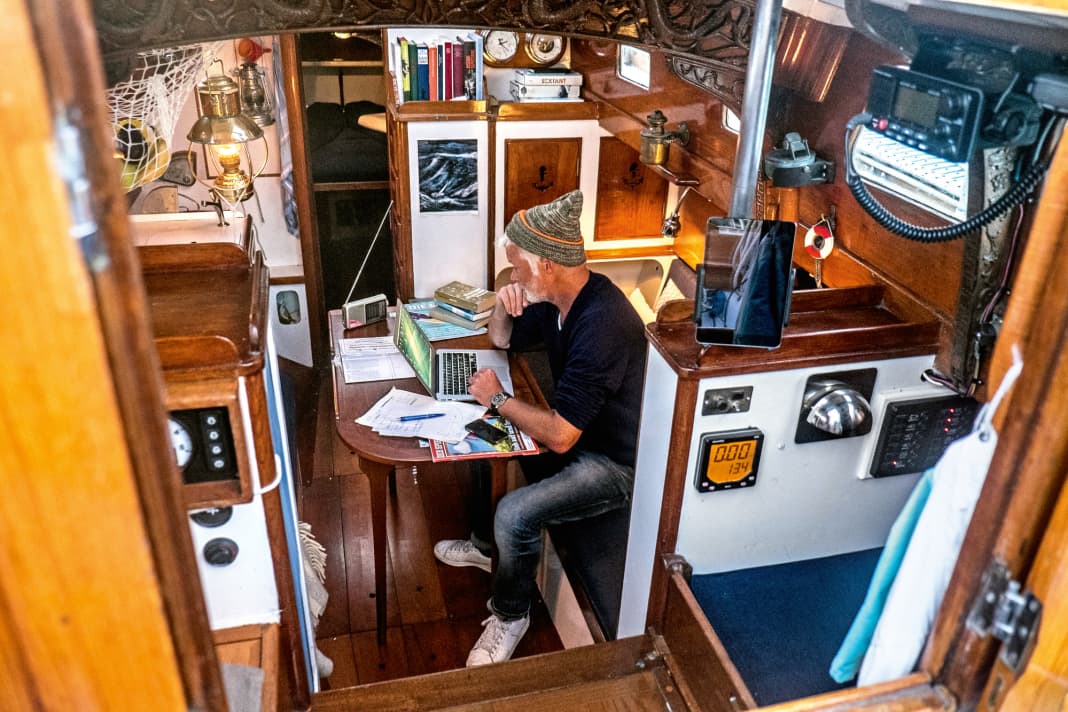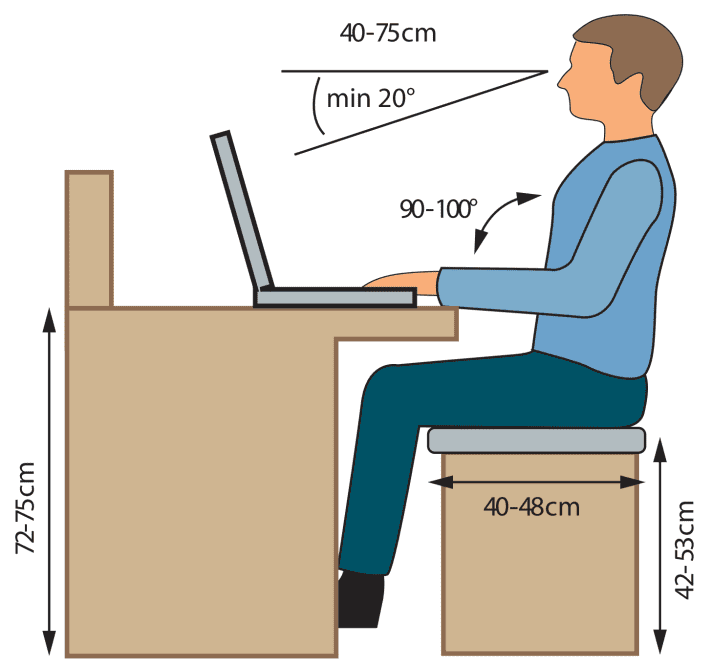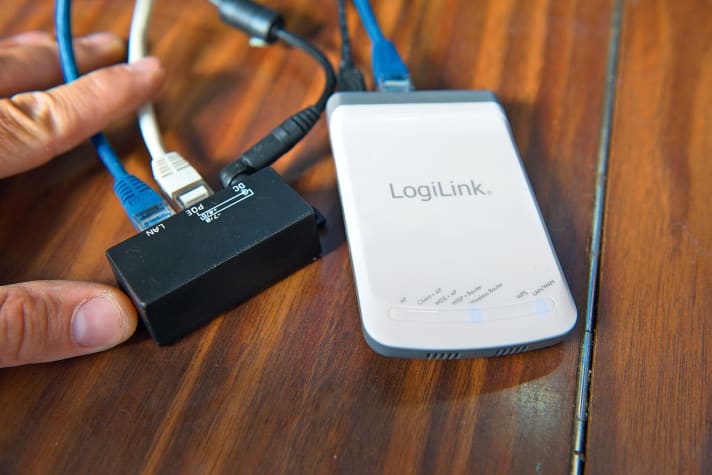Working on board: Boat office - a refuge or a real alternative to the office?






In this article:
Working from home is now completely normal. The coronavirus pandemic and increasingly adaptable working time models in particular have brought flexible forms of work to the fore. Those who do not necessarily have to rely on the existing infrastructure at their local workplace for their work can now often carry out their tasks at home or from any other location. And it has been shown that teleworking seems to work sustainably on a broad basis, and better than many employers could have imagined.
For boat owners, working on board is now a tempting model. In the boat office, desk work can basically be done just as well as from home. In recent years in particular, this idea has driven many working sailors out onto their boats in great euphoria, their notebooks under their arms and their mobile phones in their pockets. But in many cases, it's not quite that simple after all - especially if work in the office on board is to become permanent. If you want to work a lot and often on the boat, you need to customise the boat office to your needs. Otherwise, frustration and inconvenience - and therefore inefficiency - can quickly set in.
How Boat-Office can work
Work discipline and clearly defined duty time management are among the most important basic requirements for constructive work on board. The danger of distraction is latent: Harbour and wind noise, noisy neighbours, adventurous harbour manoeuvres, children playing on the jetty or spontaneous visits for a chat on board can suddenly interrupt concentration and the flow of work. Isolating yourself completely from your surroundings will generally be difficult or even impossible on a boat, at least in the harbour.
The presence of one or even several additional people on board can also be a distraction for those wanting to work - even more so in the confines of a boat than at home with more generous space. Even at home, teleworking and family life can generally only be combined to a limited extent. This becomes particularly difficult on small ships. If you don't manage to concentrate on your work in the boat office, sooner or later you will fail.
Fully furnished ship offices
The ergonomically correct sitting position at the workplace is just as important for relaxed, efficient work on board. Of course, this is difficult to achieve on a ship. YACHT author Marc Bielefeld speaks from experience. He has been working from the ship for years, sometimes for several months at a time, and has tried out every possible sitting position on board. "I can't sit on the soft cushions in the saloon for hours on end. So during the day, I move here and there to write." The larger the ship, the more options there are. If you work exclusively with a notebook, you can sit outside in the cockpit from time to time. The problem: when the sun is shining, you often can't see much on the laptop screen.
The luxury variants for an office on board come directly from the shipyard. Manufacturers of upmarket yachts such as Hallberg-Rassy in Sweden or Contest Yachts in the Netherlands already offer ready-made office furnishings for their larger vessels as an expansion option, or they can fulfil special requests with individual adaptations. The Sirius shipyard in Germany has already realised complete office solutions for owners on various occasions, including on smaller models. Demand continues to rise sharply, especially in these times. Shipyard boss Torsten Schmidt: "The topic has become super topical with Corona, we are constantly receiving enquiries for boats with office equipment, especially from sailors with blue water intentions."
One problem that should not be underestimated when working on board is the constant swaying of the boat in the anchorage or harbour. Anyone who tends to feel uncomfortable with small rocking movements below deck will probably never be really happy in the boat office. Especially when working intensively at a computer screen, the visual reference to the natural horizon is lost over time. This can result in balance problems and, in the worst case, even the threat of seasickness. Businessmen Maren and Matthias Wagner, who have been working from a boat for years, switched from a monohull to a catamaran that is more stable in the water for precisely this reason. So anyone thinking of setting up an office on board should first try out whether they can cope with working on the water for several hours a day.
The technical equipment in the boat office
Electronic work equipment such as computers, additional screens or printers require electricity, and usually not in short supply. What is not a problem at home in your own office can lead to restrictions on the boat and then requires conversion measures. After all, the electricity here is supplied by batteries and is therefore limited, at least as long as you are not in harbour where you have a constant supply of shore power. In addition, the usual on-board voltage of 12 or 24 volts is too weak to operate the electrical part of the office infrastructure.
The short-term solution to the problem is to install an inverter. Such devices transform the direct voltage from the batteries into alternating voltage of 230 volts. This is temporarily sufficient to recharge a laptop or operate an external monitor, for example. Of course, the power reserves from the batteries are still limited. If you need to be independent of shore power for a longer period of time, you will therefore hardly be able to avoid installing a power generator. Additional energy suppliers for longer periods of autonomy on board can also be solar modules or wind generators.
However, the power supply on board is not only an important issue for electrical equipment, but also for creating a pleasant indoor climate in the office on the boat. In southern climes, permanently installed or mobile air conditioning systems can provide valuable services; devices in various performance levels and price segments are available for this purpose. Electric fan heaters, on the other hand, provide warmth below deck during the cold season. Mobile gas heaters or hot air heaters with diesel burners permanently installed in the boat are reliable and electricity-free alternatives.
The right climate on board
Moisture in the ship remains an almost unavoidable problem for work on board. In summer, when the interiors can be ventilated frequently and intensively, the difficulties are significantly less than in winter, when condensation moisture is added to the already hazy salt water air. For humans, this humid climate is unpleasant and possibly unhealthy, but for the folding computer and other electronic equipment on board, the high humidity is simply destructive. Corrosion and oxidation on device components can quickly lead to contact problems and malfunctions.
The only way to combat high humidity on board is regular ventilation or additional electric dehumidifiers, which are only suitable for use with a continuous shore power supply. These devices generally consume a relatively large amount of electricity, although there are considerable differences depending on the design and quality.
If you want to play it safe technically when working on board, you will want to opt for a so-called Toughbook. These very robust, sometimes even completely waterproof devices are particularly suitable for outdoor applications, including onboard use. However, Toughbooks are usually quite heavy and expensive compared to conventional laptops.
The switch from the office on land to the boat office is attractive for water sports enthusiasts because the topics of work and leisure can be combined, at least spatially. Some will make the move without any problems and quickly familiarise themselves with the new working environment on the boat. Others, on the other hand, will soon abandon the idea because the accompanying circumstances are not very favourable. Whether the boat office model works and can be an alternative to teleworking is something that everyone has to decide for themselves.
In any case, it helps to simply try it out.
Sit correctly, work relaxed
If you often work in the boat office, you should set up your workstation ergonomically. Pay attention to this

In most cases, neither the sofas in the saloon nor the stool in the navigation area are designed for long-term sitting on a sailing boat. In many cases, just a few measures are enough to prevent annoying complaints such as tension, back pain or headaches. With ergonomically shaped seat cushions, footrests or height-adjustable pads for the keyboard, the correct posture at the workplace can be adjusted and improved with little effort. Important: The thighs should rest on the seat and the distance between the hollow of the knee and the cushion should be at least two fingers wide. The workstation should preferably be equipped with a backrest that ensures an upright posture. The angle between the lower leg, thigh and torso should be at least 90 degrees for good posture. A lack of legroom at the workstation can lead to discomfort in the long term. What helps is movement and standing up regularly.
Strong network, efficient processes
A fast Internet connection is one of the basic requirements for office work on board. There are many ways to access the web

What could be more annoying than a stuttering, slow internet connection at work - especially when large amounts of data need to be accessed, downloaded or sent? Anyone working from the boat office is usually in the harbour, where Wi-Fi may be available free of charge - in theory at least. In practice, however, the harbour network at the berth is often poor and often cannot be received at all below deck.
External W-Lan antennas for use on board, which are available from boat equipment suppliers from as little as 90 euros, can provide a remedy for transmission and reception problems in the harbour. However, these omnidirectional antennas for mobile use are at best suitable for optimising reception on board. In contrast, waterproof Wi-Fi antennas, which are mounted on the masthead and connected to a router below deck via Ethernet cable, offer significantly better performance. This allows a wireless and reliable network to be set up on board as a hotspot, which additional devices such as smartphones, tablets or chart plotters can also log into. Nevertheless, the connection can still be slow, for example if the harbour network is overloaded by many users. In this case, only mobile routers that establish the Internet connection via UMTS and LTE networks can help, although this requires a SIM card with a contract.

